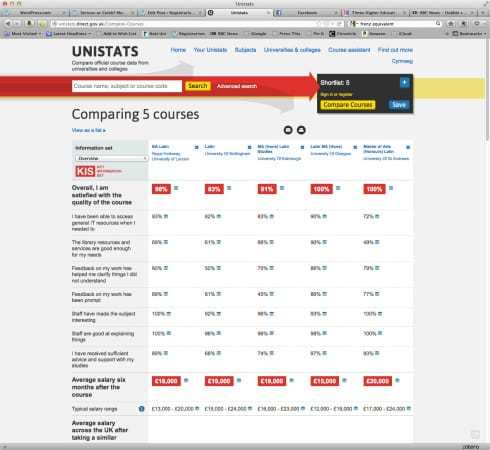A report on the use made of Unistats
HEFCE has published an evaluation of the Unistats website after its first period of operation. It suggests that the huge demands made of institutions in providing the necessary data have paid off as Unistats has already become “one of the most widely used higher education course comparison websites”.
Since its launch in September 2012, the Unistats web-site has received over 3.8 million page views and over 175,000 unique visitors – an average of 984 new visitors per day. The site is used extensively by prospective higher education students, their parents, careers advisers, teachers and higher education staff.
The research, commissioned by the Higher Education Funding Councils, looks at the site’s position in the market and how it is perceived and used, as well as issues such as navigation, search, filter and comparison functions, and data presentation. A separate report by the Higher Education Statistics Agency (HESA) focuses on the experiences and views of higher education institutions.
Key findings include:
The average length of visit to the site is over eight minutes (a long time compared with use of other web-sites).
Many users regarded the independent and authoritative nature of the site as one of its key strengths.
Prospective students, current students and parents were more positive about the site than careers advisers, teachers and higher education staff, and more likely to describe the site as ’useful’ and ‘easy to get around’.
All very gratifying for Unistats fans. But as an earlier post noted there really is no shortage of information on HE opportunities. The most worrying element of this report though is the eight minute visit. Whilst this is undoubtedly a comparatively long time for a website visit it really is a frighteningly short time to spend looking at possible course choices.













I agree, it looks suspicious. Possible explanations for the 8 minute average: 1. The site is used to simply confirm judgements made elsewhere through various socially mediated or autonomous deliberative processes (see Archer’s recent study of undergraduates in The Reflexive Imperative in Late Modernity for an account of the variations in student decision making process); 2. Users find the course choice experience so overwhelming that they just run away in confusion/despair/terror. My guess is that there are many reasons, but Unistats probably is not playing as central a role in decision making as its usage stats at first suggest. More… Read more »
I would query the value of the site, as they say in the report “This would be consistent with a substantial proportion of use by professionals or employees during their working day (whereas other potential users might be able and expected to use the site more uniformly over the week). We infer that a substantial proportion of usage to date has been by careers professionals, others in advisory roles and HE staff, but expect that this balance will change with increasing maturity of the site.” So much of the traffic may not be the target audience of students. For me… Read more »
I was about to make a comment along the lines of Robert’s first point. Unistats won’t usually be the very first place prospective students start looking for information. When they do visit, comparisons can be made relatively quickly. This may be an exercise in confirmation bias, whether or not that’s a good thing. Eight minutes may not sound like much, but when you know what you want to look up, the Unistats site isn’t that difficult to navigate. Comparisons are quick to make too. In addition, have average visits under a minute or so been excluded? I assume many people… Read more »
Agreed